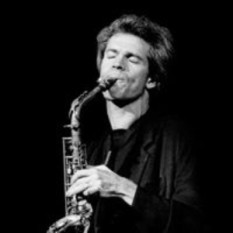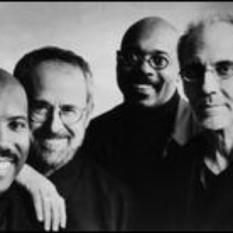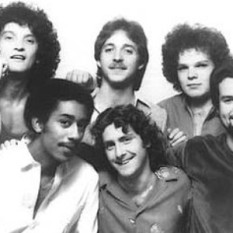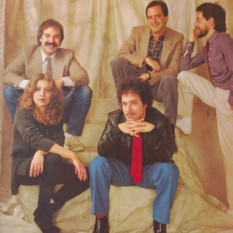palanduz sait
Biographies
Here you'll find information about the group and its members. Discover how the group was formed, and the direction they've taken on their musical journey. Read about the individual Jackets' musical influences, the equipment they use, and their lifetime experiences. Key members of earlier Yellowjackets configurations are represented in our alumni section, including blues guitarist Robben Ford, drummers Ricky Lawson and Will Kennedy, and saxophonist Marc Russo.
Yellowjackets History
In 1977, Robben Ford assembled a group of veteran session musicians to record his album The Inside Story. The trio of musicians, which included keyboardist Russell Ferrante, bassist Jimmy Haslip and drummer Ricky Lawson, soon discovered a certain "chemistry" and musical affinity that led to their formation of Yellowjackets. The Inside Story being mainly instrumental, Robben Ford's record label wanted him to record another album that was more pop and vocal oriented. The group, known as the Robben Ford Group, preferred to pursue the instrumental route, and a "band within a band" was formed. This same group with Robben Ford on guitar recorded digital demos that were eventually accepted by Warner Brothers, and Yellowjackets was born. While Robben's contributions would diminish over the years to being a guest artist, the group known as Yellowjackets would flourish.
Their debut album Yellowjackets made serious waves in jazz radio, garnering public and critical acclaim. Mirage A Trois followed in its footsteps. While they went on a brief hiatus to pursue other projects, they reassembled in time for the 1984 Playboy Jazz Festival, adding percussionist Paulinho Da Costa and their new lead voice, sax man Marc Russo. This landmark concert paved the way for their eventual success both on the Billboard Jazz charts and concert venues around the world, and resulted in the third spicy Yellowjackets album Samurai Samba. 1986 saw the group moving over to MCA Records to record Shades, the title track being written by Donald Fagen (of Steely Dan fame) as a tribute to the many "shades" he heard in the group's music.
With their album Four Corners, Ricky Lawson departed to join Lionel Richie's touring band and was replaced by the versatile William Kennedy. This rock-solid lineup took the Yellowjackets into new territory, exploring world beats and densely-populated soundscapes that reflected a growing maturity in their music. CloudjacketsPolitics, the follow-up to Four Corners, mellows out, and the group sheds some of the electronic elements and starts exploring acoustic sounds. Marc Russo's final recording with Yellowjackets, The Spin, was recorded in Oslo, Norway by noted engineer Jan Erik Kongshaug (well known for his work on the ECM label), and the Jackets proved that they could belt out acoustic jazz with the best!
Greenhouse ushered in a new era. With Marc gone, the Yellowjackets trio would record one of their most adventurous albums to date, featuring ace big band arranger and saxophonist Bob Mintzer on many of the tracks, and string accompaniments on a handful of others. Shortly thereafter, Bob Mintzer became a bona fide member of Yellowjackets. The Jackets also recorded on one of Bob Mintzer's dmp Records projects, One Music. Live Wires captures the group in concert with Mintzer at the helm. The two albums that followed, Like A River and Run For Your Life, reflected a growing interest in straight-ahead acoustic jazz.
With 1995's Dreamland, Yellowjackets returned to their first record label, Warner Brothers, producing their most relaxed, and relaxing, recording to date. Blue Hats is more spontaneous than its predecessors, musically rich and particularly revealing in showing how Yellowjackets have evolved since that landmark first album. Club Nocturne, their latest studio recording, achieves great crossover appeal with the guest vocalists Kurt Elling, Jonathan Butler and Brenda Russell. And while the Yellowjackets of today sound little like the original Yellowjackets from fifteen-plus years ago at first listen, the unmistakable talents of the individuals involved still have the unique signatures that shine through regardless of their musical setting, whether it be blistering-hot fusion or full-blown acoustic jazz. In other words, their music has evolved and matured considerably, but there's no mistaking that it is Yellowjackets you are hearing.
At the beginning of 1999, William Kennedy departed Yellowjackets to pursue other interests, and Peter Erskine joined the group for the balance of the year. Peter had played with Bob Mintzer on some of his big-band and small group recordings, so it was a natural that he would become one of the Yellowjackets. Unfortunately, Erskine's busy schedule would conflict with the band's, and he would depart by year's end without ever having recorded an album with the group.
In early 2000, the Yellowjackets were once again a trio, with Russell, Jimmy and Bob using different drummers as they continue touring throughout the year. Two of the fine drummers they've hooked up with were Marcus Baylor and Terri Lynn Carrington. For 2000, the band also saw a change in management, and Jimmy's long-awaited (and long-delayed) solo recording, Red Heat, was released later in the summer.
In 2001, the band self-released the pivotal live "Mint Jam" recording, with Marcus Baylor now essentially the band's full-time drummer. Since that time, the Jackets signed a deal with the HeadsUp International label, and have since released "Time Squared", the holiday release "Peace Round" and, most recently, "Altered State".
What's In A Name? If you're expecting something cute or meaningful in the naming of the group, you may be disappointed. Russell Ferrante relates the following on how the group's name was chosen: "I wish there was a clever rationale, but there really isn't. At the time we were making our demo in hopes of landing a recording contract, we were still the "Robben Ford Band". We had recorded one record with Robben, (primarily instrumental) but his record company was "encouraging" him do do something more pop and vocal oriented. As we also wanted to continue playing instrumental music, we all decided to form a "band within a band" so to speak. At the demo session Jimmy brought in a sheet full of possible names, most just awful. The one that popped out was Yellowjackets as it seemed to connotate something lively, energetic, and something with a "sting". That's really about as deep as it went. Once you choose a name, you're stuck with it so here we are, 16 years later, grown men playing in a band named 'Yellowjackets.'"
Marcus Baylor
Marcus Baylor, a native of St. Louis, began playing the drums at two years old. Watching his cousin play every Sunday morning fascinated him so much so that after each service, he'd jump on the set and mimmick what he heard first hand. At home, he played on everything from pots and pans, to his mother's living room furniture. It soon became evident that this was a gift from God and should be taken seriously. Not long after, Marcus became the official drummer at his father's church. From that point on, he played at tent revivals, concerts and all services affiliated with the church. "Playing at church was the greatest start I could ever have because I constantly played and it served as a platform to develop a sound."
Marcus' introduction to jazz came in junior high school. Ironically, a friend played him a Yellowjackets record. Although different, there were certain similarities in their music and gospel, the music Marcus was so familiar with. But, something sparked in him the first time he saw jazz played live.What attracted him to this music was that it was something he never heard and found it to be a challenge, a new sound to develop. After scratching the surface, Marcus was eager to learn about those that came before them. He discovered Art Blakey and The Jazz Messengers, Thelonious Monk, Miles Davis, and many other jazz greats. As Marcus became more exposed to this music, he excelled quickly in the language of jazz. He joined his school jazz band, won the Southern Illinois University high school big band competition and made All District Jazz Band.
At the close of high school, Marcus was offered a four year scholarship at Mannes School of Music in New York City. This was his first chance to study the music from a traditional perspective. He was fortunate to study with some of his musical heroes, Lewis Nash, Chico Hamilton, Michael Carvin and Buster Williams. Being in New York City afforded him all that was available in the jazz world from being able to hear great musicians as well as play with them. During his sophomore year, Marcus began playing local gigs, one of which was with the music director for Cassandra Wilson, who invited him for an audition with the band. This was a significant turning point in Baylor's career as he recorded for the first time with Wilson on "Travelin' Miles", featuring the music of Miles Davis. "Playing with Cassandra, I learned to hear and play different textures, or 'colors' as she called it, and explore different dynamics." While on tour, there were many memorable moments as renowned artists sat in with the band. Among them were George Benson, Dave Holland, Regina Carter and Olu Dara. Meanwhile, Baylor earned his Bachelor of Fine Arts degree.
Following Wilson, Marcus began working with Kenny Garrett. He explains this opportunity as "a dream come true". For Marcus, this was a chance to open up and explore another side of playing jazz music. More than just a musician, Kenny was also a teacher and mentor. Working with him, Marcus gained a tremendous understanding of the history of rhythm, phrasing and ultimately a sound within the music. It also granted him an enormous amount of exposure as others heard him play and consequently opened up many doors. He recorded a song with Kenny on the album, "Happy People". Also on the road with Garrett, Marcus was exposed to playing with other greats such as Chick Corea and Freddie Hubbard. Independently, Baylor has worked with John Scoffield, Joshua Redman (Elastic Band), Greg Osby, Cyrus Chestnut, Stephon Harris, Junior Mance, Nicholas Payton, Lamont Johnson and East St. Louis native, Russell Gunn.
As Marcus Baylor comes into his own, he has found himself in the chair of one of the longest running and most loved contemporary jazz groups. Marcus has been playing with the Yellowjackets since 2000. In that time, he recorded his first record with them, "Mint Jam", a live recording at The Mint in California, and "Time Squared". When asked what he likes most about being a part of the Yellowjackets, "The Yellowjackets allow me the creative space to lend my own personality to the music. It's been a blessing and a dream come true to play with a group that I've listened to for so many years." Concerning his future, Marcus adds, "Music is a special gift from God. As it has blessed me, I pray that it will be used as a light to reach, touch and inspire lives all over the world."
Russell Ferrante
Background: Russ�s first exposure to music came from his church, where his father was the choir director as well as being a frequent vocal soloist and having a vocal gospel quartet. His father�s whole family were music lovers and several of his brothers and sisters have marvelous voices, something Russ admits never got passed on to him. "I began piano lessons at 9 with the expectation that I'd one day be the church pianist. My musical interests took me elsewhere but my sister who is 2 years younger actually went on to fulfill my parent's dreams and is now directing the music program for a church in Watsonville, CA," Russ says.
Beside his early interest in the piano, Russ also tried other instruments, making the most headway on drums, even going as far as playing drums on a couple of gigs and recording sessions. His experience with the drums has benefited his piano and keyboard playing and composing as a result.
As for musical education, Russ relates the following: "I took piano lessons from a wonderful piano teacher in San Jose, CA named Ann Penner, from age 9-16 or so, nothing fancy, just the basics. I got interested in jazz and pop around the age of 15 and studied jazz from whatever sources were available, notably scattered lessons with local jazz musicians, jazz theory books that I found or were recommended to me, and listening to my favorite recordings and transcribing songs and solos. Regrettably I never formally studied music in school."
Influences: "The first recording I heard that really got me excited about being a musician was "Swiss Movement" by Les McCann and Eddie Harris. I loved the way the musicians combined jazz, R&B, and gospel music. This marriage of jazz and R&B was something I heard a lot around San Jose where I grew up. There was one musician in particular, Clifford Coulter, who greatly inspired me.
"Around the same time, I was introduced to John Coltrane's 'My Favorite Things' and various recordings by Miles Davis. I didn't understand that music at all but nonetheless, I immediately loved it! Along with these recordings, I was listening to and drawing inspiration from The Beatles, "Sgt. Pepper's Lonely Heart Club Band" and Joni Mitchell's first album "Clouds"."
Non-Yellowjackets Projects
"I've been privileged to write with and produce records for: Bobby McFerrin, Al Jarreau, Michael Franks, Diane Reeves, Rita Coolidge, Sadao Watanabe, Marilyn Scott, Kevyn Lettau, Eric Marienthal, and Sergio Salvatore among others. I've also arranged for Take 6, The GRP Big Band, Lee Ritenour, and many others."
Artists Russ Has Performed With: "There are so many, but at the risk of omitting some, I'd say my favorite have been: Jimmy Witherspoon, Jim Pepper, Joe Farrell, Joni Mitchell, Bobby McFerrin, Robben Ford, Al Jarreau, Marilyn Scott, Kevyn Lettau, Ernie Watts, Sadao Watanabe, GRP Big Band, Lee Ritenour, Tom Scott, Take 6, Michael Franks, Eric Marienthal, and Brenda Russell."
What does Russ listen to? "Everything by John Coltrane, especially "Giant Steps", "Ballads", "A Love Supreme", and "Live at Birdland". Everything by Miles Davis, especially "Kind of Blue", "Milestones", "My Funny Valentine", "Four and More", "Sketches of Spain", "Miles Smiles", and "Nefertiti". Keith Jarrett, especially "Facing You", "My Song", "Belonging", and all the "standards" recordings. Weather Report, especially "Heavy Weather". Eddie Harris, especially "Listen Here", "Silver Cycles" and "Swiss Movement". Orchestral music by Debussy, Ravel, Stravinsky, Copeland, Bartok, Samual Barber, and much, much more."
Equipment: Russ uses a Steinway & Sons grand piano, Roland JV2080, Korg Triton, and SGProX. G4 laptop w/ Logic, Protools LE, Finale, and Unity Session.
Jimmy Haslip
immy�s bass is an integral part of the Yellowjackets sound. In addition to building the foundation upon which their songs are crafted, his thoughtful and often fiery solos are a high water mark of many Yellowjackets tracks.
Background: Jimmy Haslip grew up in a rich musical environment. As a youth, he listened to Latin and salsa music around the house, including such Latin music icons as Tito Puente, Mongo Santamaria, Machito, Ray Barretto, Celia Cruz and Eddie Palmieri, to name a few. In addition to learing various Latin dances from his parents, Jimmy learned how to play a lot of basic Latin rhythms on the different percussion instruments that they had around the house. He learned to play authentically on the claves, maracas, cowbell, bongos and the guido, which gave him that keen sense of time and rhythm that surfaces in his bass playing today.
His older brother Gabriel also played Jimmy some jazz and classical music, so he had exposure to John Coltrane, Charlie Parker, Eric Dolphy, Miles Davis and Dave Brubeck on one hand, and the music of Debussy, Stravinsky, Beethoven, Mozart and Mahler on the other. Jimmy says, "This was an eye opening time for me and even though most of this music was over my head, it definitely ignited my musical curiosity. I also was listening to a lot of Pop music, like the Beatles, the Supremes, The Four Tops, The Temptations, Wilson Pickett, James Brown and lots of great Pop music on the radio. I can remember that it was a very exciting time for music!
Jimmy began studying music in elementary school, playing the trumpet and other assorted brass instruments (including the bugle, baritone horn and tuba) from age seven to fourteen. Jimmy picked up a bass at the age of fifteen and taught himself how to play it. "Actually the very first time I saw an electric bass, was at a junior high Valentine's day dance. There was a live band playing and the bass player had an reddish/orange Hagstrom bass and a small Standel bass amp. It was then that I knew I wanted to play the electric bass! What a feeling! I'll never forget it as long as I live. It was my very first real spark of creative passion!
While being mostly self taught on the bass, Jimmy studied with a private bass/tuba player from New York named Ron Smith. He was also very fortunate to have studied with one of jazz music�s greatest talents. "�I did manage to study with Jaco Pastorius for a few weeks in the mid seventies, when he had just joined Weather Report. That was a giant leap for me as a serious musician and it filled me with a much higher level of inspiration. I think he was a major inspiration to all bass players at that time!
To sum it up, Jimmy offers this inspirational piece of advice that is applicable to any musician, whether it be a Beginner or experienced/advanced: "I've basically learned so much from just about every musician I've performed with in the past and I will continue to learn from my experiences in the future. The learning process is never ending. The key is to always strive and search for knowledge. In learning new things everyday, there will be inspiration. That inspiration will thirst for knowledge and so the endless cycle goes. They will feed each other infinitely and theoretically the creative well will never run dry.
Influences: So, what musical influences does Jimmy claim? "Well definitely for me the Beatles, especially Paul McCartney, inspired the melodic concept and James Brown inspired the groove. Then there is Scott LaFaro, Tito Puente and Mongo Santamaria who inspired rhythm. Béla Bartók, Mozart, Prokofiev, Samuel Barber, Chick Corea, early Genesis, Gentle Giant, Olivier Messiaen, Mozart, Dmitri Shostakovich, Krzysztof Penderecki, Antonio Carlos Jobim, Pablo Casals, Ron Carter, Mstislav Rostopovich, Villalobos, Brahms, Wayne Shorter, Joe Zawinul, Jaco Pastorius, Alban Berg, Charles Mingus, Miles, Nicolas Slominski, John Coltrane, Led Zepplin, Tower of Power, Francis Rocco Prestia, Yes, Thelonious Monk, Charlie Parker, Sting, Sergei Prokofiev, Peter Gabriel, Joni Mitchell, Count Basie, Duke Ellington, Billy Strayhorn, Tony Williams, Keith Jarrett,
John McGlaughlin, The Motown Sound and Aaron Copeland, Leonard Bernstein;
just to name a few that inspired my playing, arranging and compositional skills.
Van Gogh, Dali, Henri Rousseau, Georgia O'keeffe, Leonardo DaVinci, Galileo, Einstein, Nikola Tesla, Plato, Walt Whitman, Nostradamas, Steven Hawking, Marc Chagall, Tamayo, Henry Moore, Edward Hopper, Rembrandt, Picasso, Botero, Dali, Matisse, Escher, Canaletti, Gaudi, Gauguin, Federico Fellini, Alfred Hitchcock, Steven Speilberg, Frank Capra, Orson Welles, Gary Cooper, Cary Grant, Barbara Stanwyck, Jean Arthur, Myrna Loy, James Stewart, Tom Hanks, Meryl Streep, Lina Wertmuller, Ingmar Bergman, François Truffaut to name a few who inspired my imagination.
And last but not least, perhaps the most influential person in Jimmy�s career: Jimi Hendrix was the sole inspiration for me playing music as a profession. Seeing him perform live was awesome and it lit a fire within me, which eventually gave me the drive to pursue music as a career.
Jimmy...
Tüm albümler
En iyi müzik arama motoru aracılığıyla bilgi bulabilirsiniz - Muzlan.top 😊Tüm materyaller istek üzerine "Yellowjackets" Yellowjackets. Sayfada mevcuttur
Evet tabi ki. Parçaları Yellowjackets sayfasından dinleyebilirsiniz
Evet tabi ki. Parçaları Yellowjackets sayfasından indirebilirsiniz
Bu sayfa sorgular tarafından bulunur: Yellowjackets song download, Yellowjackets track minus, Yellowjackets all mp3, Yellowjackets flac, Yellowjackets free download




